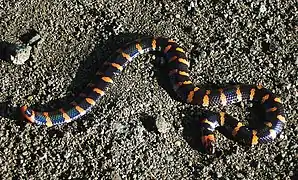Cylindrophis ruffus
Cylindrophis ruffus ou Serpent à deux têtes est une espèce de serpents de la famille des Cylindrophiidae[1].

- Anguis ruffa Laurenti, 1768
- Cylindrophis rufus (Laurenti, 1768)
- Anguis striatus Gmelin, 1789
- Cylindrophis resplendens Wagler, 1828

LC : Préoccupation mineure
Répartition
Cette espèce se rencontre[1] :
Description


Ce serpent mesure de 70 à 100 cm de long. Le dessous de sa queue est rouge, queue qui rappelle la tête de serpent venimeux comme le bongare et lui vaut le surnom de serpent à deux têtes.
Il est essentiellement fouisseur mais on peut le trouver dans les rizières et les marécages.
Il mange de petits serpents et des anguilles.
C'est un serpent vivipare[2].
Taxinomie
On rencontre parfois cette espèce sous le nom de Cylindrophis rufus (avec un seul f), mais la graphie originale de Laurenti, 1768 comporte bien les deux f. La sous-espèce Cylindrophis ruffus burmanus[3] a été élevée au rang d'espèce par Amarasinghe et al., 2015[4].
Publication originale
- Laurenti, 1768 : Specimen medicum, exhibens synopsin reptilium emendatam cum experimentis circa venena et antidota reptilium austriacorum, Vienna Joan Thomae, p. 1-217 (texte intégral).
Liens externes
- (en) Référence Animal Diversity Web : Cylindrophis ruffus (consulté le )
- (en) Référence Catalogue of Life : Cylindrophis ruffus (Laurenti, 1768) (consulté le )
- (fr+en) Référence ITIS : Cylindrophis ruffus (Laurenti, 1768) (consulté le )
- (en) Référence NCBI : Cylindrophis ruffus (taxons inclus) (consulté le )
- (en) Référence Reptarium Reptile Database : Cylindrophis ruffus (Laurenti, 1768) (consulté le )
- (en) Référence UICN : espèce Cylindrophis ruffus Laurenti, 1768 (consulté le )
Bibliographie
- Pauwels, David, Chimsunchart & Thirakhupt, 2003 : Reptiles of Phetchaburi Province, Western Thailand: a list of species, with natural history notes, and a discussion on the biogeography at the Isthmus of Kra. Natural History Journal of Chulalongkorn University, vol. 3, no 1, p. 23-53.
- Pauwels, Laohawat, David, Bour, Dangsee, Puangjit & Chimsunchart, 2000 : Herpetological investigations in Phang-Nga Province, southern Peninsular Thailand, with a list of reptile species and notes on their biology. Dumerilia, vol. 4, no 2, p. 123-154.
- Underwood, 2002 : On the rictal structures of some snakes. Herpetologica, vol. 58, no 1, p. 1-17.
- Zug, Win, Thin, Min, Lhon, Kyaw, 1998 : Herpetofauna of the Chatthin Wildlife Sanctuary, north-central Myanmar with preliminary observations of their Natural History Hamadryad, vol. 23, no 2, p. 111-120.
Notes et références
- Reptarium Reptile Database, consulté lors d'une mise à jour du lien externe
- Collectif (trad. Martine Lamy), Le règne animal, Gallimard Jeunesse, , 624 p. (ISBN 2-07-055151-2), Serpent à deux têtes
- Smith, 1943 : The Fauna of British India, Ceylon and Burma, Including the Whole of the Indo-Chinese Sub-Region. Reptilia and Amphibia. 3 (Serpentes). p. 1-583.
- Amarasinghe, Campbell, Hallermann, Sidik, Supriatna & Ineich, 2015 : Two new species of the genus Cylindrophis Wagler, 1828 (Squamata: Cylindrophiidae) from Southeast Asia. Amphibian & Reptile Conservation, vol. 9, no 1, p. 34–51.
- Portail de l’herpétologie
- Portail de l’Asie